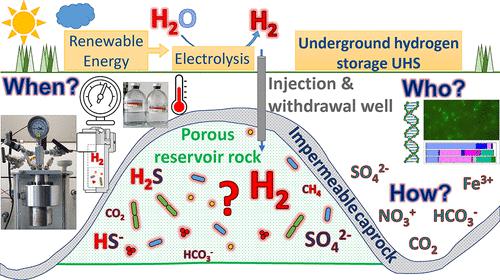当前位置:
X-MOL 学术
›
Environ. Sci. Technol.
›
论文详情
Our official English website, www.x-mol.net, welcomes your
feedback! (Note: you will need to create a separate account there.)
Microbial H2 Consumption by a Formation Fluid from a Natural Gas Field at High-Pressure Conditions Relevant for Underground H2 Storage
Environmental Science & Technology ( IF 10.8 ) Pub Date : 2023-01-04 , DOI: 10.1021/acs.est.2c07303
Anja B Dohrmann 1 , Martin Krüger 1
Environmental Science & Technology ( IF 10.8 ) Pub Date : 2023-01-04 , DOI: 10.1021/acs.est.2c07303
Anja B Dohrmann 1 , Martin Krüger 1
Affiliation

|
Underground hydrogen storage (UHS) has been proposed as one option for storage of excess energy from renewable sources. Depleted gas reservoirs appear suitable, but at the same time, they may be environments with potentially high microbial abundances and activities. Hydrogen (H2) is one of the most energetic substrates in such environments, and many microorganisms are able to oxidize H2, potentially leading to loss of H2 or other unwanted reactions like production of, e.g., H2S, clogging, or corrosion. This study addressed the potential of H2 consumption by naturally abundant microorganisms in formation fluid from a gas field at near in situ pressure and temperature conditions. Microbial H2 consumption was evident at ambient and 100 bar and tolerated pressure variations reflecting cycles of H2 storage. Temperature strongly influenced the activity with higher activity at 30 °C but lower activity at 60 °C. The activity was sulfate-dependent, and sulfide was produced. The microbial community composition changed during H2 consumption with an increase in sulfate-reducing prokaryotes (SRP). Thus, the presence of an SRP-containing, H2-consuming microbial community with activity at UHS-relevant pressure and temperature conditions was shown and should be taken into account when planning UHS at this and other sites.
中文翻译:

与地下储氢相关的高压条件下天然气田地层流体的微生物氢气消耗
地下储氢 (UHS) 已被提议作为储存来自可再生能源的多余能量的一种选择。枯竭的气藏似乎是合适的,但与此同时,它们可能是具有潜在高微生物丰度和活动的环境。氢 (H 2 ) 是此类环境中最具能量的底物之一,并且许多微生物能够氧化 H 2,可能导致 H 2损失或其他不需要的反应,例如产生 H 2 S、堵塞或腐蚀。本研究探讨了近原位气田地层流体中天然丰富的微生物消耗H 2的潜力压力和温度条件。微生物 H 2消耗在环境压力和 100 bar 下很明显,并且耐受的压力变化反映了 H 2储存的周期。温度强烈影响活性,在 30 °C 时活性较高,但在 60 °C 时活性较低。活性是硫酸盐依赖性的,并产生硫化物。随着硫酸盐还原原核生物 (SRP) 的增加, H 2消耗期间微生物群落组成发生了变化。因此,显示了在 UHS 相关压力和温度条件下具有活性的含 SRP、消耗 H 2的微生物群落的存在,并且在规划该地点和其他地点的 UHS 时应将其考虑在内。
更新日期:2023-01-04
中文翻译:

与地下储氢相关的高压条件下天然气田地层流体的微生物氢气消耗
地下储氢 (UHS) 已被提议作为储存来自可再生能源的多余能量的一种选择。枯竭的气藏似乎是合适的,但与此同时,它们可能是具有潜在高微生物丰度和活动的环境。氢 (H 2 ) 是此类环境中最具能量的底物之一,并且许多微生物能够氧化 H 2,可能导致 H 2损失或其他不需要的反应,例如产生 H 2 S、堵塞或腐蚀。本研究探讨了近原位气田地层流体中天然丰富的微生物消耗H 2的潜力压力和温度条件。微生物 H 2消耗在环境压力和 100 bar 下很明显,并且耐受的压力变化反映了 H 2储存的周期。温度强烈影响活性,在 30 °C 时活性较高,但在 60 °C 时活性较低。活性是硫酸盐依赖性的,并产生硫化物。随着硫酸盐还原原核生物 (SRP) 的增加, H 2消耗期间微生物群落组成发生了变化。因此,显示了在 UHS 相关压力和温度条件下具有活性的含 SRP、消耗 H 2的微生物群落的存在,并且在规划该地点和其他地点的 UHS 时应将其考虑在内。

































 京公网安备 11010802027423号
京公网安备 11010802027423号